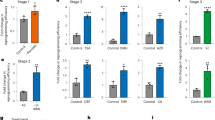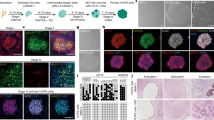Abstract
Small molecules can control cell fate in vivo and may allow directed induction of desired cell types, providing an attractive alternative to transplant-based approaches in regenerative medicine. We have chemically induced functional oocytes in Caenorhabditis elegans adults that otherwise produced only sperm. These findings suggest that chemical approaches to therapeutic cell reprogramming may be feasible and provide a powerful platform for analyzing molecular mechanisms of in vivo cell reprogramming.
This is a preview of subscription content, access via your institution
Access options
Subscribe to this journal
Receive 12 print issues and online access
$259.00 per year
only $21.58 per issue
Buy this article
- Purchase on Springer Link
- Instant access to full article PDF
Prices may be subject to local taxes which are calculated during checkout


Similar content being viewed by others
References
Gurdon, J.B. & Melton, D.A. Science 322, 1811–1815 (2008).
Zhou, Q., Brown, J., Kanarek, A., Rajagopal, J. & Melton, D.A. Nature 455, 627–632 (2008).
Xu, Y., Shi, Y. & Ding, S. Nature 453, 338–344 (2008).
North, T.E. et al. Nature 447, 1007–1011 (2007).
Castaigne, S. et al. Blood 76, 1704–1709 (1990).
Kimble, J. & Crittenden, S.L. Annu. Rev. Cell Dev. Biol. 23, 405–433 (2007).
Ellis, R. & Schedl, T. in WormBook (ed. The C. elegans Research Community) doi/10.1895/wormbook.1.82.1 (4 April 2006). http://www.wormbook.org>
Barton, M.K., Schedl, T.B. & Kimble, J. Genetics 115, 107–119 (1987).
Lee, M.-H. et al. Genetics 177, 2039–2062 (2007).
Sundaram, M.V. in WormBook (ed. The C. elegans Research Community) doi/10.1895/wormbook.1.80.1 (11 February 2006). http://www.wormbook.org>
Berset, T., Fröhli Hoier, E., Battu, G., Canevascini, S. & Hajnal, A. Science 291, 1055–1058 (2001).
Bachorik, J.L. & Kimble, J. Proc. Natl. Acad. Sci. USA 102, 10893–10897 (2005).
Albertson, D.G., Rose, A.M. & Villeneuve, A.M. Chromosome organization, mitosis, and meiosis. in C. elegans II (eds. Riddle, D.L., Blumenthal, T., Meyer, B.J. & Priess, J.R.) 47–78 (Cold Spring Harbor Laboratory Press, Cold Spring Harbor, New York, USA, 1997).
Favata, M.F. et al. J. Biol. Chem. 273, 18623–18632 (1998).
Duncia, J.V. et al. Bioorg. Med. Chem. Lett. 8, 2839–2844 (1998).
Gumienny, T.L., Lambie, E., Hartwieg, E., Horvitz, H.R. & Hengartner, M.O. Development 126, 1011–1022 (1999).
Church, D.L., Guan, K.-L. & Lambie, E.J. Development 121, 2525–2535 (1995).
Barrett, S.D. et al. Bioorg. Med. Chem. Lett. 18, 6501–6504 (2008).
Alessi, D.R., Cuenda, A., Cohen, P., Dudley, D.T. & Saltiel, A.R. J. Biol. Chem. 270, 27489–27494 (1995).
Dudley, D.T., Pang, L., Decker, S.J., Bridges, A.J. & Saltiel, A.R. Proc. Natl. Acad. Sci. USA 92, 7686–7689 (1995).
Lee, M.-H. et al. PLoS Genet. 3, e233 (2007).
Subramaniam, K. & Seydoux, G. Curr. Biol. 13, 134–139 (2003).
Hajnal, A. & Berset, T. EMBO J. 21, 4317–4326 (2002).
Tenen, D.G. Nat. Rev. Cancer 3, 89–101 (2003).
McLachlan, R.I., Rajpert-De Meyts, E., Hoei-Hansen, C.E., de Kretser, D.M. & Skakkebaek, N.E. Hum. Reprod. 22, 2–16 (2007).
Acknowledgements
We thank S. Ward (University of Arizona) and B. Grant (Rutgers University) for providing reagents. We are grateful to L. Vanderploeg, A. Steinberg and A. Helsley-Marchbanks for help preparing the figures and manuscript. We thank the Kimble lab members for helpful discussions. This work was supported by US National Institutes of Health grant RO1 GM069454. J.K. is an investigator with the Howard Hughes Medical Institute.
Author information
Authors and Affiliations
Contributions
C.T.M. and M.-H.L. performed the experiments. C.T.M., M.-H.L. and J.K. analyzed the results. C.T.M. and J.K. wrote the manuscript.
Corresponding author
Supplementary information
Supplementary Text and Figures
Supplementary Methods, Supplementary Figures 1–4 and Supplementary Table 1 (PDF 5811 kb)
Rights and permissions
About this article
Cite this article
Morgan, C., Lee, MH. & Kimble, J. Chemical reprogramming of Caenorhabditis elegans germ cell fate. Nat Chem Biol 6, 102–104 (2010). https://doi.org/10.1038/nchembio.282
Received:
Accepted:
Published:
Issue Date:
DOI: https://doi.org/10.1038/nchembio.282
This article is cited by
-
A pumilio homolog in Polycelis sp.
Development Genes and Evolution (2014)
-
Chemically reprogramming cell fates
Nature Chemical Biology (2010)
-
Grand Challenge Commentary: Chemical transdifferentiation and regenerative medicine
Nature Chemical Biology (2010)



